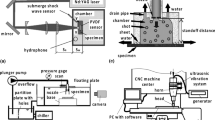Abstract
The present study addresses the effect of multiple jet passes and other parameters namely feedrate and pressure in waterjet peening (WJP) of austenitic stainless steel 304. An analysis of surface integrity was used to evaluate the performance of different parameters in the WJP process. An increase in the number of jet passes as well as pressure leads to a higher roughness and more erosion of the surface. However, the feedrate shows a reverse effect on the surface roughness and erosion. The surface microstructures also show the mechanism of material removal process involving initial and evolved damages. The subsurface hardness shows that treating the surface with a higher number of passes and pressure produces a higher increase of hardness and also a deeper hardening layer. But, a reverse effect on the subsurface hardness was found for the feedrate. Furthermore, cross-sectional microstructures show a higher density of slip bands in the deformed grains of the specimen treated with a higher number of jet passes and pressure. However, the amount of slip bands in the deformed grains is lower with increasing feedrate.
Similar content being viewed by others
References
Daoming G, Jie C (2006) ANFIS for high-pressure waterjet cleaning prediction. Surf Coat Technol 201:1629–1634
Cui L, An L, Gong W, Jiang H (2007) A novel process for preparation of ultra-clean micronized coal by high pressure water jet comminution technique. Fuel 86:750–757
Arola D, McCain ML, Kunaporn S, Ramulu M (2002) Waterjet and abrasive waterjet surface treatment of titanium: a comparison of surface texture and residual stress. Wear 249:943–950
Ramulu M, Arola D (1994) The influence of abrasive waterjet cutting conditions on the surface quality of graphite/epoxy laminates. Int J Mach Tools Manuf 34:295–313
Cadavid-Giraldo R (2004) Cutting with fluidjets of small diameter. Dissertation, Technische Universität Kaiserslautern
Cadavid R, Wüstenberg D, Louis H, Pude F, Senne T (2005) Effect of helium atmospheres on abrasive suspension water jets. Int J Adv Manuf Technol 26:1246–1254
Chillman A, Ramulu M, Hashish M (2007) Waterjet peening and surface preparation at 600 MPa: a preliminary experimental study. J Fluids Eng 129:485–490
Grinspan AS, Gnanamoorthy R (2006) A novel surface modification technique for the introduction of compressive residual stress and preliminary studies on Al alloy AA6063. Surf Coat Technol 201:1768–1775
Karabelchtchikova O, Rivero IV (2005) Variability of residual stresses and superposition effect in multipass grinding of high-carbon high-chromium steel. J Mater Eng Perform 14:50–60
Zhang B, Yang F, Wang J, Zhu Z, Monahan R (2000) Stock removal rate and workpiece strength in multi-pass grinding ceramics. J Mater Process Technol 104:178–184
Wang J, Guo DM (2003) The cutting performance in multipass abrasive waterjet machining of industrial ceramics. J Mater Process Technol 133:371–377
Bigdeli Karimi M, Arabi H, Khosravani A, Samei J (2008) Effect of rolling strain on transformation induced plasticity of austenite to martensite in a high-alloy austenitic steel. J Mater Process Technol 203:349–354
Arola D, Alade AE, Weber W (2006) Improving fatigue strength of metals using abrasive waterjet peening. Mach Sci Technol 10:197–218
Bringas JE (2004) Handbook of comparative world steel standards, 3rd edn. ASTM International, Massachusetts
Barriuso S, Lieblich M, Multigner M, Etxeberria I, Alberdi A, González-Carrasco JL (2011) Roughening of metallic biomaterials by abrasiveless waterjet peening: characterization and viability. Wear 270:634–639
Oka YI, Mihara S, Miyata H (2007) Effective parameters for erosion caused by water droplet impingement and applications to surface treatment technology. Wear 263:386–394
Kong MC, Axinte D, Voice W (2010) Aspects of material removal mechanism in plain waterjet milling on gamma titanium aluminide. J Mater Process Technol 210:573–584
Field JE (1999) ELSI conference: invited lecture, liquid impact: theory, experiment, applications. Wear 233–235:1–12
Sahaya Grinspan A, Gnanamoorthy R (2006) Surface modification by oil jet peening in Al alloys, AA6063-T6 and AA6061-T4, Part 2: surface morphology, erosion, and mass loss. Appl Surf Sci 253:997–1005
Shen L, Wang L, Wang Y, Wang C (2010) Plasma nitriding of AISI 304 austenitic stainless steel with pre-shot peening. Surf Coat Technol 204:3222–3227
Ju DY, Han B (2009) Investigation of water cavitation peening-induced microstructures in the near-surface layer of pure titanium. J Mater Process Technol 209:4789–4794
Author information
Authors and Affiliations
Corresponding author
Rights and permissions
About this article
Cite this article
Azhari, A., Schindler, C., Kerscher, E. et al. Improving surface hardness of austenitic stainless steel using waterjet peening process. Int J Adv Manuf Technol 63, 1035–1046 (2012). https://doi.org/10.1007/s00170-012-3962-1
Received:
Accepted:
Published:
Issue Date:
DOI: https://doi.org/10.1007/s00170-012-3962-1




